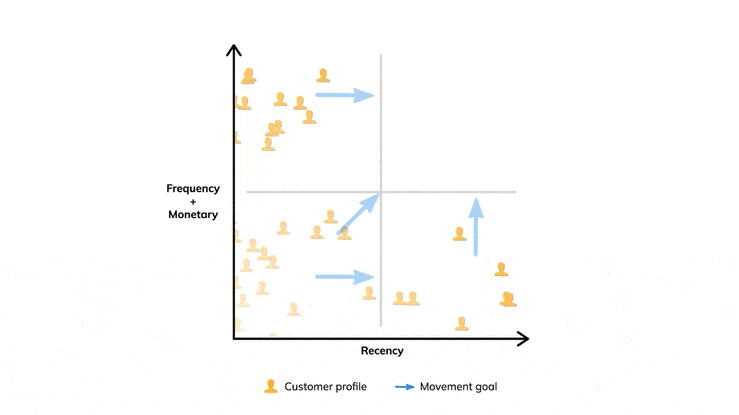For hospitality and retail brands, understanding your customers and their purchasing behavior is critical to long-term success. With today’s data management technology, you have a wealth of information about your customers at your fingertips. And with the right strategies in place, you can extract plenty of helpful insights.
At Skypoint Cloud, we use RFM analysis, powered by AI, to help our retail and hospitality clients understand their customers’ purchasing patterns. Our insight offers a unique look at the ways customers engage with your brand. This information helps you create a more personalized marketing strategy that keeps your customers engaged.
What is RFM Analysis?
RFM stands for: recency, frequency, and monetary value.
RFM analysis uses these three attributes of customer behavior to break your customers into segments, which you can then use to inform and adapt your marketing strategy.
- Recency is when the customer last made a purchase from your organization.
- Frequency is the number of purchases a customer has made from you, either in total or during a specific period of time.
- Monetary value is the amount of money the customer spends during a transaction.

Why is RFM Analysis Important for Retail and Hospitality?
Many organizations already use customer segments based on demographics. They may segment their customers based on factors like age or gender identity to determine how these factors affect purchasing behavior, and adjust their marketing strategy in turn.
RFM analysis allows you to go beyond demographics and investigate consumer behavior patterns in a more nuanced way.
While demographics are static, the RFM model takes a look at dynamic consumer behaviors, giving you the tools to adjust your marketing strategy over time. In your personal life, you likely would not treat a new acquaintance the same as you would treat an old friend, this is true of your customers, too. You don’t want to market to brand-new customers the same way you market to your most loyal customers who make frequent large purchases.
RFM segmentation also provides helpful information about the ways that your customers are responding to your marketing. For example, after a retargeting campaign, you might opt to analyze the monetary value of your transactions to determine how effective the campaign was and make strategic changes for future campaigns based on segmentation
Skypoint Cloud’s RFM Model
Skypoint Cloud makes it easy to set up RFM analysis for your organization. Our RFM model makes scalable, automated personalization possible.
How to Calculate RFM
To launch the RFM analysis, you need records of transaction dates and purchase amounts tied directly to customer records.
The software then assigns a numerical value for recency, frequency, and monetary value to each of your customers based on their transaction information.
The highest RFM score possible for a customer is 5/5/5, but this is extremely rare. It will take a bit of time and close observation to determine what an ideal score is for your business.
Factors That Affect Your RFM Score
There are a variety of factors that affect your RFM scores in general, such as the type of products you’re selling, price point, and how your customers purchase them, whether that’s in a brick-and-mortar store or online.
Skypoint Cloud’s RFM analysis breaks your customer base down into ten standard segments. Once you’ve collected enough data, you’ll be able to set goals and use this information to create RFM customer segments to suit your brand’s needs.
An RFM Success Story: Better Analysis and Customer Engagement
One RFM analysis example, our work with a West Coast donut brand, is a compelling display of the results that Skypoint Cloud can deliver.
They realized that their recency scores were relatively low because a large percentage of their customer base were tourists. As a result, they adjusted their RFM segmentation to assess recency over a much longer period of time to determine whether customers were coming back on repeat trips. This will also be used to start identifying customers where e-commerce is a better sales channel since they do not have easy access to retail locations.
Additionally, this brand used recency and frequency data to determine what types of marketing emails to send to their customers. After their first purchase, customers receive a welcome email, and with repeat purchases, they get updates about new donut flavors and deals. If a formerly-loyal customer hasn’t made a purchase in a while, they receive an email to re-engage them.
Get Strategic About Segmentation to Boost Marketing Success
If you’re looking for more actionable customer insights to improve your marketing strategy, now is the perfect time to implement RFM analysis and customer segmentation. Skypoint Cloud makes it easy to upload customer data and run your analysis automatically. This gives you a scalable method for creating targeted and lucrative marketing campaigns. Schedule a demo today to learn more about Skypoint Cloud for retail and hospitality.











